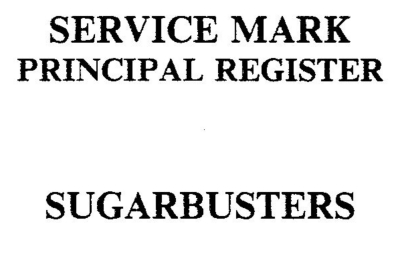“Use of the mark by the [trademark] assignee in connection with a different goodwill and different product would result in a fraud on the purchasing public who reasonably assume that the mark signifies the same thing… Therefore, if consumers are not to be misled from established associations with the mark, [the mark must] continue to be associated with the same or similar products after the assignment.” – Fifth Circuit Court of Appeals
 Co-author and publisher, Sugar Busters LLC, purchased the registered service mark SUGARBUSTERS (Reg. No. U.S. 1,684,769). Then Sugar Busters LLC tried to sue on Ellen Brennan for trademark infringement based on the registration, but lost when it sought a preliminary injunction. Sugar Busters lost because the registered mark was for retail services, which were not related to the Sugar Buster’s book publication/sales activities.
Co-author and publisher, Sugar Busters LLC, purchased the registered service mark SUGARBUSTERS (Reg. No. U.S. 1,684,769). Then Sugar Busters LLC tried to sue on Ellen Brennan for trademark infringement based on the registration, but lost when it sought a preliminary injunction. Sugar Busters lost because the registered mark was for retail services, which were not related to the Sugar Buster’s book publication/sales activities.
Trademark Rights are Connected to Goods/Services
Trademark rights are connected to the goods and/or services with which they are used. This is why speculating in trademark without use is generally pointless. “A trademark is merely a symbol of goodwill and has not independent significance apart from the goodwill that it symbolizes,” the Fifth Circuit said in Sugar Busters LLC V. Brennan, 177 F. 2d 258 (5th Cir. 1999). Trademarks cannot be sold separate from the goodwill which they represent (the terms trademark and service mark are used interchangeably in this post).
The sale of a trademark without its associated goodwill is characterized as a sale “in gross” and is invalid. The rule prohibiting the sale of a trademark in gross is “to prevent a consumer from being misled or confused as to the course and nature of the goods or services that he or she acquires.”
Therefore any sale or assignment of trademark right should recite that the goodwill associated with the mark(s) is assigned to the buyer. With respect to registered marks, this requirement is found at 15 USC 1060(a)(1), which provides “A registered mark or a mark for which an application to register has been filed shall be assignable with the goodwill of the business in which the mark is used, or with that part of the goodwill of the business connected with the use of and symbolized by the mark.” The transfer of goodwill does not generally need to be accompanied with the transfer of any physical or tangible assets of the former trademark owner.
However, while reciting the transfer of goodwill in the assignment is important, it is not enough. “Use of the [trademark] by the assignee [purchaser] in connection with a different goodwill and a different product would result in a fraud on the purchasing public who reasonably assumed that the mark signifies the same thing, whether used by one person or another.” Therefore, a trademark assignment needs to recite the transfer of goodwill of the business in which the mark is used and the purchaser of trademark rights needs to continue the use of the mark on the same or similar goods/services as were provided by the prior owner of the mark.
Sugar Busters
In the Sugar Busters case, Sugar Busters LLC co-authored and published a book entitled “SUGAR BUSTERS! Cut Sugar to Trim Fat” in 1995. The book sold over 210,000 copies. In 2007, Sugar Busters LLC granted permission to one of its founders, H. Leighton Steward, to independently create a cookbook based on the principles outlined in the original SUGAR BUSTERS! book. Steward and Sugar Busters LLC employee Ellen Brennan agreed to co-author the cook book. But in December 1997, Sugar Busters LLC withdrew its permission for the cookbook and determined its partners should not engage in independent projects. Ellen Brennan proceeded to co-author the cookbook “SUGAR BUST For LIFE!” without Steward, which was punished in May of 1998.
Between the time that Sugar Busters LLC withdrew its permission and the date the “SUGAR BUST For LIFE!” book was published, Sugar Busters LLC purchased the SUGARBUSTERS service mark, registered as U.S. trademark registration number 1,684,769. It is not clear whether the service mark was purchased with an eye to litigation, but the timing of the purchase indicates it might have been.
The SUGARBUSTERS trademark registration was for “retail store services featuring products and supplies for diabetic people; namely, medical supplies, medical equipment, food products, informational literature and wearing apparel featuring a message regarding diabetes.” Therefore the retail store services of the trademark registration were different from the books sold by Sugar Busters LLC.
The court found that the trademark was in valid because plaintiff’s book and the retail store services were not sufficiently similar to prevent consumer confusion or deception when plaintiff used the mark previously associated with the store as the title of its book. As a result, the preliminary injunction based on the registration was vacated.
Conclusion
The transfer of ownership of a trademark should involve at least: (1) an assignment that recites the transfer of the trademark, (2) the assignment recites the transfer of goodwill of the business in which the trademark is used, and (3) the purchaser of trademark continuing the use of the trademark on the same or similar goods/services as were provided by the prior owner of the trademark.